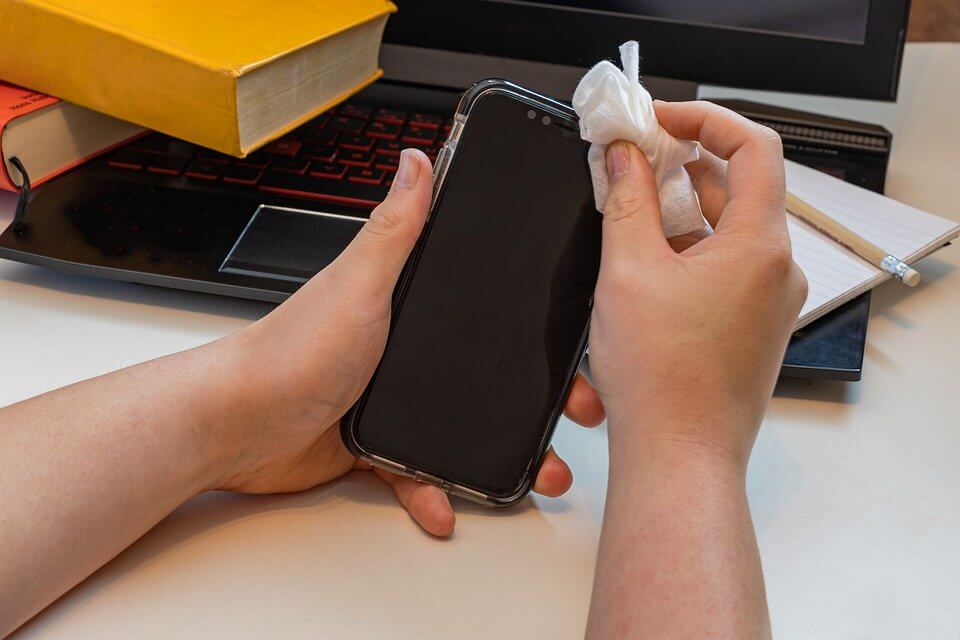The rapid spread of COVID-19 has seen an unprecedented social need to keep hands and surfaces disinfected. While sanitizing surfaces is not so difficult – sprays and wipes abound – cleaning electronics, workstations and server setups clean is much more of a challenge. Organizations with comprehensive IT have their work cut out keeping their hardware safe and operational.
Streaming Netflix more than usual? There’s an IT team committed to keeping servers performing seamlessly and sanitized.
In this article we are offering simple ways to sanitize devices and keep clients and employees safe. These are useful even if much of the staff is working from home.
How coronavirus is spread from person to person
Novel coronavirus is transmitted from individual to individual directly and indirectly. Some direct means of spreading the virus to another person of group of people are sneezing or coughing without covering the nose and mouth and by shaking hands. An indirect means of transmission is when someone carrying coronavirus touching surfaces such as door handles and keyboards, which are then touched by other people.
How to keep employees safe – at work and at home
Organizations face a daunting task trying to keep essential workers safe at work and employees safe at home (from contaminated equipment they may carry from the workplace). Here are things that should be cleaned and sanitized to minimize the risk of spreading COVID-19:
- Workstations
- Smartphones and tablets
- TV screens
- Flash drives and removable media
- Cables and wiring
- Server racks
- Keyboard and mouse
- Remotes
- Presentation devices
To be effective at killing coronavirus, sanitizing wipes and sprays must have an alcohol content of at least 70%.
There is a common understanding that sanitizing wipes and sprays must have an alcohol content of at least 70% to be an effective disinfectant. However, that does not mean they are suitable for cleaning screens, IT equipment and circuit boards. The formulation of any such sanitizer can dry out adhesives, cause short circuits and permanently damage screens.
How to sanitize and disinfect different electronic devices
Make sure the device you are about to clean is powered off and disconnected from its power source. Here is the two-step regimen you should follow:
Clean – Remove grime and debris that can hide coronavirus
Sanitize – Use a spray or wipe with at least 70% alcohol to sanitize a surface
Optional: Disinfect – Specialized solution or device to completely disinfect device (not possible with every device)
Read more
Risks of using pirated software | Fake CEO and phishing scams | Protect your network from an attack
Cleaning workstations
Use moist wipes to wipe down workstations. Sanitizing wipes should not be dripping wet else moisture can enter the housing and damage sensitive electronics. Be mindful of touchpoints such as the touchpad, mouse, keyboard and power buttons that are handled frequently.
Cleaning the keyboard and mouse
Use compressed air to knock out debris stuck behind and in-between keys. On the mouse, thoroughly dust the scroll wheel too. To take out tougher dirt, use tape or a piece of Blu Tac (or other brand of adhesive putty). Then use a sanitizing wipe to clean all surfaces. Do not use sprays as these can cause circuit boards inside the device to short circuit.
Sanitizing smartphones and tablets
Be careful when cleaning touchscreens. Some wipes can leave an oily residue, others can discolor screens and render the device unusable. Lysol wipes are a common disinfecting wipe found around the office and are safe to use on Apple’s iPhones. Phone sanitizers can be used too, but make sure to read reviews before selecting one. Check your device manufacturer’s advice on using alcohol wipes. An alternative is a damp microfiber cloth mixed with soap.
Regardless of method, make sure moisture does not accumulate in speaker grills, around buttons and in the charging port.
Rise of the ‘UV safe’ to complete disinfect phones: Beware! Only one of three types of UV rays can kill coronavirus.
Disinfecting headphones, earphones and microphones
Earphones and headsets are in close and prolonged proximity with the head and mouth and need to cleaned thoroughly. Start by taking off ear tips and pads. If these can be washed, do so. Clear out any debris in the speaker grill with a tooth pick or adhesive putty. After that, sanitize the headphone assembly with isopropyl alcohol or a sanitizing wipe.
Laptop
The ultimate tool of the modern employee, the laptop can become a coronavirus trap unknowingly. Sitting on café tables and benches, being used remotely in hotels and conference venues, a laptop is susceptible to picking up germs – and transferring them to the user. Start by turning the laptop upside down, opening the screen and gently shaking the dust and dirt out of the keyboard tray. Then use rubbing alcohol or a sanitizing wipe to clean the entire surface of the laptop. Older laptops don’t have tough glass screens and can be damaged by oily wipes. Use a dedicated screen cleaner or ‘phone sanitizer’ solution to clean their screens.
Wires and cables
Do not use bleach or household disinfectants on computer or networking cables and wiring. These are extremely abrasive and can damage the protective sheathing around the wiring. Instead, use a soapy damp cloth and run the wire through it. A disinfecting wipe can be used instead.
Flash drives, presentation remotes, TV remotes and other small media
For smaller items like USB flash drives, remote controls and presentation aids, clean crevices with compressed air, a toothpick or adhesive putty. Then disinfect the surface with a wipe or rubbing alcohol. While the COVID-19 is at its peak, avoid device sharing as much as possible.
At Technical Action Group we are educating clients to develop best practices for cleaning equipment. Our operations are functioning at full capacity to ensure cloud service uptime. We are working with business owners to configure operations for optimum work from home operations.


